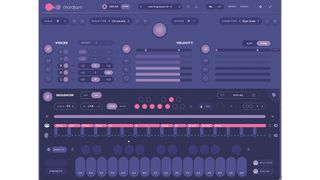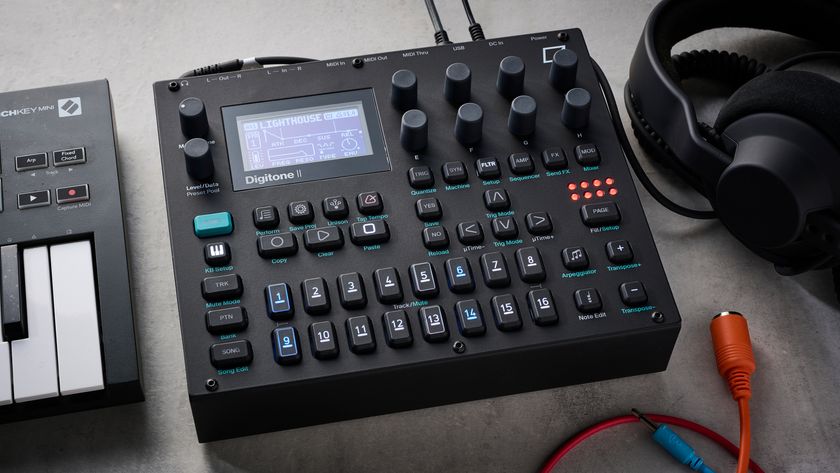MusicRadar Verdict
More than simply a chord progression cheat code, Chordjam is one of the most useful, creative compositional tools around.
Pros
- +
Easy to use but highly customisable.
- +
Flexible system of packs and presets.
- +
Randomisation and ‘robot’ mode are very inspiring.
Cons
- -
MPE capabilities could be a bit more extensive.
MusicRadar's got your back
Audiomodern Chordjam 1.5: What is it?

Formats: VST, VST3, AU, AAX. Also available as AUv3/standalone for iPad.
OS: macOS 10.12 or higher (64-bit only), Windows 7 or higher (32 / 64-bit compatible)
Buy at Plugin Boutique
Audiomodern’s plugins fall into the broad category of ‘theory assistant’ tools – applications designed to offer a helping hand when it comes to creating patterns, grooves and progressions.
What sets them apart from other plugins in this space, however, is an emphasis on a creative configuration that make Audiomodern plugins feel less like a theory cheat code and more like an experimental sandbox.
Chordjam is a prime example of this. First released in 2021, but recently updated to v1.5, Chordjam is a chord generator that can turn single-note inputs into melodically coherent progressions.
That in itself is nothing that innovative, but Chordjam goes further in the ‘smart’ control it offers over every aspect of the MIDI it outputs.
Audiomodern Chordjam 1.5: Performance and verdict
Chordjam can be triggered either from an external MIDI input or its internal sequencer. In either case, the plugin will generate chords with up to five voices.
Along the top of the UI, users can select a scale, octave and chord type – with 54 chord shapes to choose from – to control the pitch of these voicings.
With the notes in the chord itself, Chordjam also lets users control the individual velocity and timing of the notes played, the latter section also offering up a simple arpeggiator.
Where it gets really interesting is in how it can randomise elements
Where the plugin becomes really interesting is in the ways it can randomise all of these elements individually. Randomisation can happen in one of two ways, a simple roll of the dice to create a fresh set of settings, or an ‘infinite’ mode, whereby Chordjam randomises parameters each time it triggers a new chord.
There are extensive options to configure what, and by how much, randomisation is applied; users can, for example, select chord shapes or several scales to create a pool of possibilities, or set ranges for the potential timing and velocity of each voice.
This approach carries through to the sequencer, which can be edited manually, but is most fun when used in ‘robot’ mode, whereby Chordjam will automatically generate patterns using as much (or as little) guidance as you want to give it.
The result is a plugin that feels less like it’s doing the work for you, and more like a highly flexible, generative tool, akin to the best Eurorack sequencers, albeit with easier routing and recall.
Version 1.5 enhances the plugin in a couple of ways. The first is by adding MPE. This means that Chordjam can now be routed to an MPE instrument – assuming the DAW you’re using allows this – allowing it to bend from one chord to the next.
There are options to dictate the amount and range of the bend applied. It’s a nice addition although it would be good to see it go further to really take advantage of the capabilities of MPE – perhaps offering control over which voices do and don’t bend – and some randomisation.
This version also overhauls the system of presets and packs. Users don’t just get a huge, expandable range of ready-to-go progressions, but they can also make custom ‘packs’ of MIDI progressions complete with bespoke artwork.
MusicRadar verdict: More than simply a chord progression cheat code, Chordjam is one of the most useful, creative compositional tools around.
Audiomodern Chordjam 1.5: Hands-on demos
Audiomodern
ADSR Music Production Tutorials
HollywoodFloss1
Audiomodern Chordjam 1.5: Specifications
- Formats: VST, VST3, AU, AAX. Also available as AUv3/standalone for iPad, priced at $9.99.
- Buy at Plugin Boutique
- CONTACT: Audiomodern
I'm the Managing Editor of Music Technology at MusicRadar and former Editor-in-Chief of Future Music, Computer Music and Electronic Musician. I've been messing around with music tech in various forms for over two decades. I've also spent the last 10 years forgetting how to play guitar. Find me in the chillout room at raves complaining that it's past my bedtime.
![Justin Hawkins [left] of the Darkness plays an open G on his offset electric and closes his eyes as he performs onstage; soul-reggae icon Johnny Nash [right] frets a chord on his acoustic and wears a patched denim jacket.](https://cdn.mos.cms.futurecdn.net/hWzCjD9ZWQiPPjMtTWiFfa-840-80.jpg)
“It was probably the first time I’d ever sort of listened to one and gone, ‘What is that? I want to learn how to do that!’”: How a soul and reggae legend introduced the Darkness' Justin Hawkins to diminished chords

"This risked giving consumers the misleading impression that platinum tickets were better”: Ticketmaster criticised over Oasis reunion tickets debacle, but this time it's got nothing to do with dynamic pricing

“He was not an actor, he was a singer-songwriter, and they told him he was going to write and record his own music. And basically, he was not allowed to do that": Micky Dolenz explains Mike Nesmith's "frustration" at being in The Monkees










